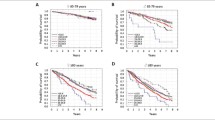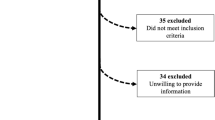Abstract
Background
In Latin America, knowledge about the demography and health status of adults aged 100 years and over is scarce. Insufficient studies of the elderly population in Costa Rica exist despite having a “Blue Zone” (geographical area with a high concentration of centenarians) in the Peninsula of Nicoya, with a high percentage of centenarians in the districts of Santa Cruz, Nicoya, Hojancha, Nandayure and Carrillo.
Aims
To describe the clinical, functional, mental and social profile of centenarians residing in the Blue Zone of the Peninsula of Nicoya, Costa Rica.
Methods
This is a cross-sectional study using a population base of 43 community-dwelling centenarians. A comprehensive geriatric assessment was performed, including sociodemographic information, health status, electrocardiogram and laboratory tests.
Results
The mean age of centenarians was 101.93 years, of whom 18 (42%) were men and 25 (58%) women. Two (4.6%) resided in nursing homes. Women had worse results than men in the evaluation of dependence on basic and instrumental activities of daily living, and the short physical performance battery performance test. A high prevalence of low Vitamin D levels (87.3%), atrial fibrillation (9.3%) and visual impairment (46.5%) was found.
Conclusions
This is the first study describing the medical, functional, mental and social profile of centenarians in the Peninsula of Nicoya (Blue Zone) in Costa Rica. This population has a high prevalence of malnutrition and hypertension with dependence on the basic activities of daily living, and a low prevalence for diabetes, depression, ischemic heart disease, chronic obstructive pulmonary disease, and polypharmacy.
Similar content being viewed by others
References
Sachdev PS, Levitan C, Crawford J et al (2013) The Sydney Centenarian Study: methodology and profile of centenarians and near-centenarians. Int Psychogeriatr 25:993–1005
Zeng Y et al (2017) Demographics, phenotypic health characteristics and genetic analysis of centenarians in China. Mech Ageing Dev 165:86–97
Teixeira L et al (2017) Centenarians in Europe. Maturitas 104:90–95
Stathakos D et al (2005) Greek centenarians: assessment of functional health status and life-style characteristics. Exp Gerontol 40:512–518
Montesanto A et al (2017) Demographic, genetic and phenotypic characteristics of centenarians in Italy: focus on gender differences. Mech Ageing Dev 165:68–74
Ribeiro O, Teixeira L, Araújo L et al (2016) Health profile of centenarians in Portugal: a census-based approach. Popul Health Metr 14:13
Ailshire J et al (2014) Becoming centenarians: disease and functioning trajectories of older US Adults as they survive to 100. J Gerontol Ser A Biomed Sci Med Sci 70:193–201
Robine J, Romieu I, Allard M (2003) French centenarians and their functional health status. Presse Medicale (Paris, France: 1983) 32:360–364
Rochon PA et al (2014) Demographic characteristics and healthcare use of centenarians: a population-based cohort study. J Am Geriatr Soc 62:86–93
Hazra C et al (2015) Differences in health at age 100 according to sex: population-based cohort study of centenarians using electronic health records. J Am Geriatr Soc 63:1331–1337
Valdés P, Ruiz A, Pérez A et al (2017) Sociodemographic and clinical characteristics of centenarians in Mexico City. Biomed Res Int 2017:1–7. https://doi.org/10.1155/2017/7195801
Giraldo G (2009) Counting to 100: a first look at Cuba’s National Centenarian Study. MEDICC Rev 11:17–19
National Institute of Statistics and Census (INEC) (2013) Estimations and projections of the population by gender and age 1950–2050. San Jose
OPS (2017) Informe de Salud de las Américas 2017. https://www.paho.org/salud-en-las-americas-2017. Accessed 5 May 2017
Tribunal Supremo de Elecciones del Gobierno de Costa Rica. http://www.tse.go.cr/estadisticas_padron.htm. Accessed 5 May 2017
Rosero L, Dow WH, Rehkopf DH (2013) The Nicoya region of Costa Rica: a high longevity island for elderly males. Vienna Yearb Popul Res Vienna Inst Demogr Austrian Acad Sci 11:109–136
Poulain M, Pes GM, Grasland C et al (2004) Identification of a geographic area characterized by extreme longevity in the Sardinia island: the AKEA study. Exp Gerontol 39:1423–14299
Poulain M, Pes G, Grasland C et al (2004) Identification of a geographic area characterized by extreme longevity in the Sardinia island: the AKEA study. Exp Gerontol 39:1423–1429
https://www.familysearch.org. Accessed 5 May 2017
Vellas B, Guigoz Y, Gary PJ et al (1999) The mini nutritional assessment (MNA) and its use in grading the nutritional status of elderly patients. Nutrition 15:116–122
Guigoz Y, Laique S, Vellas BJ (2002) Identifying the elderly risk of malnutrition The Mini Nutritional Assessment. Clin Geriatr Med 18:737–757
Chumlea WMC, Guo SS, Steinbaugh ML (1994) Prediction of stature from knee height for black and white adults and children with application to mobility impaired or handicapped persons. J Am Diet Assoc 94:1385–1388
Chumlea WMC, Guo SS, Roche AF et al (1988) Prediction of body weight for the nonambulatory elderly from anthropometry. J Am Diet Assoc 88:564–568
Roberts H, Denison NH, Martin H et al (2011) A review of the measure of grip strength in clinical and epidemiological studies: towards standardised approach. Age Ageing 40:423–429
Guralnik J, Simonsick E, Ferrucci L et al (1994) A short physical performance battery assessing lower extremity function: association with self-reported disability and prediction of mortality and nursing home admission. J Gerontol 49:85–94
Mahoney FI, Barthel DW (1965) Functional evaluation: the Barthel Index. Md Med J 13:61–65
Lawton MP, Brody EM (1969) Assessment of older people: self-maintaining and instrumental activities of daily living. Gerontologist 9:179–186
Downton JH, Andrews K (1991) Prevalence, characteristics and factors associated with falls among the elderly living at home. Aging (Milano) 3:219–228
Yesavage JA (1998) Geriatric depression scales. Psychopharmacol Bull 24:709–711
Galvin JE, Roe CM, Powlishta KK et al (2005) The AD8 a brief informant interview to detect dementia. Neurology 65:559–564
Gussekloo J, de Craen AJ, Oduber C et al (2005) Sensory impairment and cognitive functioning in oldest-old subjects: the Leiden 85 + Study. Am J Geriatr Psychiatry 13:781–786
Arosio B et al (2017) Cognitive status in the oldest old and centenarians: a condition crucial for quality of life methodologically difficult to assess. Mech Ageing Dev 165B:185–194
Costa Rican University and National Council of the Elder Person (2008) First Report of the current situation of the older adult in Costa Rica, vol 6. National Press, San José, pp 101–106
Tettamanti M, Marcon G (2018) Cohort profile: ‘Centenari a Trieste’ (CaT), a study of the health status of centenarians in a small defined area of Italy. BMJ Open 8:e019250. https://doi.org/10.1136/bmjopen-2017-019250
Rabuñalr et al (2004) Estado de salud de los muy ancianos: situación clínica y funcional de la población centenaria. An Med Interna (Madrid) 21:543–547
World Health Organization (2016) Multimorbidity: technical series on safer primary care. http://apps.who.int/iris/bitstream/handle/10665/252275/9789241511650-eng.pdf. Accessed 18 Aug 2018
Michiyo T, Nobuyoshi H, Yasumichi A et al (2007) Morbidity of Tokyo-area centenarians and its relationship to functional status. J Gerontol Med Sci 62ª:774–782
Wastesson JW, Parker MG, Fastbom J et al (2012) Drug use in centenarians compared with nonagenarians and octogenarians in Sweden: a nationwide register-based study. Age Ageing 41:218–224
Kannel WB, Wolf PA, Benjamin EJ et al (1998) Prevalence, incidence, prognosis, and predisposing conditions for atrial fibrillation: population-based estimates. Am J Cardiol 82:2N–9N
Acknowledgements
We acknowledge to each of the centenarians for their cooperation, and to their families for their help in the interviews and the warm reception given to the research team; to the national and local health institutions of Costa Rica for their support; to Karen Andersen, MD, for helping in the analysis and interpretation of data, to Tricia Pennycook-Sawyers, MD, former Director of the Center for Strategic Development and Information in Health and Social Security, (CENDEISS), for her support in conducting the field work; Malaquías Monge, MD, for his participation and collaboration in taking laboratory samples; Gendry Diaz-Angulo, MD, Director of the Clinical Laboratory, Hospital “La Anexión”, Nicoya, Costa Rica; Sonia Zeledón for her help in the registry of information.
Author information
Authors and Affiliations
Corresponding author
Ethics declarations
Conflict of interest
The authors have no conflicting or competing interests to declare.
Statement of human and animal rights
All human and animal studies have been approved by the appropiate ethics committe and have therefore been performed in accordance with ethical standars laid down in the 1964 Declaration of Helsinki and its later amendments.
Informed consent
Not applicable.
Additional information
Publisher’s Note
Springer Nature remains neutral with regard to jurisdictional claims in published maps and institutional affiliations.
Rights and permissions
About this article
Cite this article
Madrigal-Leer, F., Martìnez-Montandòn, A., Solìs-Umaña, M. et al. Clinical, functional, mental and social profile of the Nicoya Peninsula centenarians, Costa Rica, 2017. Aging Clin Exp Res 32, 313–321 (2020). https://doi.org/10.1007/s40520-019-01176-9
Received:
Accepted:
Published:
Issue Date:
DOI: https://doi.org/10.1007/s40520-019-01176-9




